Alex Gu
Investigating Advanced Reasoning of Large Language Models via Black-Box Interaction
Aug 26, 2025Abstract:Existing tasks fall short in evaluating reasoning ability of Large Language Models (LLMs) in an interactive, unknown environment. This deficiency leads to the isolated assessment of deductive, inductive, and abductive reasoning, neglecting the integrated reasoning process that is indispensable for humans discovery of real world. We introduce a novel evaluation paradigm, \textit{black-box interaction}, to tackle this challenge. A black-box is defined by a hidden function that maps a specific set of inputs to outputs. LLMs are required to unravel the hidden function behind the black-box by interacting with it in given exploration turns, and reasoning over observed input-output pairs. Leveraging this idea, we build the \textsc{Oracle} benchmark which comprises 6 types of black-box task and 96 black-boxes. 19 modern LLMs are benchmarked. o3 ranks first in 5 of the 6 tasks, achieving over 70\% accuracy on most easy black-boxes. But it still struggles with some hard black-box tasks, where its average performance drops below 40\%. Further analysis indicates a universal difficulty among LLMs: They lack the high-level planning capability to develop efficient and adaptive exploration strategies for hypothesis refinement.
Solving Inequality Proofs with Large Language Models
Jun 09, 2025Abstract:Inequality proving, crucial across diverse scientific and mathematical fields, tests advanced reasoning skills such as discovering tight bounds and strategic theorem application. This makes it a distinct, demanding frontier for large language models (LLMs), offering insights beyond general mathematical problem-solving. Progress in this area is hampered by existing datasets that are often scarce, synthetic, or rigidly formal. We address this by proposing an informal yet verifiable task formulation, recasting inequality proving into two automatically checkable subtasks: bound estimation and relation prediction. Building on this, we release IneqMath, an expert-curated dataset of Olympiad-level inequalities, including a test set and training corpus enriched with step-wise solutions and theorem annotations. We also develop a novel LLM-as-judge evaluation framework, combining a final-answer judge with four step-wise judges designed to detect common reasoning flaws. A systematic evaluation of 29 leading LLMs on IneqMath reveals a surprising reality: even top models like o1 achieve less than 10% overall accuracy under step-wise scrutiny; this is a drop of up to 65.5% from their accuracy considering only final answer equivalence. This discrepancy exposes fragile deductive chains and a critical gap for current LLMs between merely finding an answer and constructing a rigorous proof. Scaling model size and increasing test-time computation yield limited gains in overall proof correctness. Instead, our findings highlight promising research directions such as theorem-guided reasoning and self-refinement. Code and data are available at https://ineqmath.github.io/.
Challenges and Paths Towards AI for Software Engineering
Mar 28, 2025Abstract:AI for software engineering has made remarkable progress recently, becoming a notable success within generative AI. Despite this, there are still many challenges that need to be addressed before automated software engineering reaches its full potential. It should be possible to reach high levels of automation where humans can focus on the critical decisions of what to build and how to balance difficult tradeoffs while most routine development effort is automated away. Reaching this level of automation will require substantial research and engineering efforts across academia and industry. In this paper, we aim to discuss progress towards this in a threefold manner. First, we provide a structured taxonomy of concrete tasks in AI for software engineering, emphasizing the many other tasks in software engineering beyond code generation and completion. Second, we outline several key bottlenecks that limit current approaches. Finally, we provide an opinionated list of promising research directions toward making progress on these bottlenecks, hoping to inspire future research in this rapidly maturing field.
Mixture of Parrots: Experts improve memorization more than reasoning
Oct 24, 2024


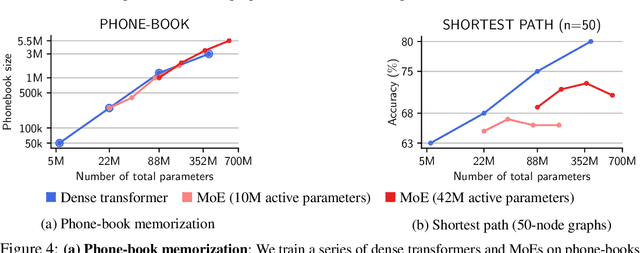
Abstract:The Mixture-of-Experts (MoE) architecture enables a significant increase in the total number of model parameters with minimal computational overhead. However, it is not clear what performance tradeoffs, if any, exist between MoEs and standard dense transformers. In this paper, we show that as we increase the number of experts (while fixing the number of active parameters), the memorization performance consistently increases while the reasoning capabilities saturate. We begin by analyzing the theoretical limitations of MoEs at reasoning. We prove that there exist graph problems that cannot be solved by any number of experts of a certain width; however, the same task can be easily solved by a dense model with a slightly larger width. On the other hand, we find that on memory-intensive tasks, MoEs can effectively leverage a small number of active parameters with a large number of experts to memorize the data. We empirically validate these findings on synthetic graph problems and memory-intensive closed book retrieval tasks. Lastly, we pre-train a series of MoEs and dense transformers and evaluate them on commonly used benchmarks in math and natural language. We find that increasing the number of experts helps solve knowledge-intensive tasks, but fails to yield the same benefits for reasoning tasks.
BigCodeBench: Benchmarking Code Generation with Diverse Function Calls and Complex Instructions
Jun 26, 2024



Abstract:Automated software engineering has been greatly empowered by the recent advances in Large Language Models (LLMs) for programming. While current benchmarks have shown that LLMs can perform various software engineering tasks like human developers, the majority of their evaluations are limited to short and self-contained algorithmic tasks. Solving challenging and practical programming tasks requires the capability of utilizing diverse function calls as tools to efficiently implement functionalities like data analysis and web development. In addition, using multiple tools to solve a task needs compositional reasoning by accurately understanding complex instructions. Fulfilling both of these characteristics can pose a great challenge for LLMs. To assess how well LLMs can solve challenging and practical programming tasks, we introduce Bench, a benchmark that challenges LLMs to invoke multiple function calls as tools from 139 libraries and 7 domains for 1,140 fine-grained programming tasks. To evaluate LLMs rigorously, each programming task encompasses 5.6 test cases with an average branch coverage of 99%. In addition, we propose a natural-language-oriented variant of Bench, Benchi, that automatically transforms the original docstrings into short instructions only with essential information. Our extensive evaluation of 60 LLMs shows that LLMs are not yet capable of following complex instructions to use function calls precisely, with scores up to 60%, significantly lower than the human performance of 97%. The results underscore the need for further advancements in this area.
LiveCodeBench: Holistic and Contamination Free Evaluation of Large Language Models for Code
Mar 12, 2024Abstract:Large Language Models (LLMs) applied to code-related applications have emerged as a prominent field, attracting significant interest from both academia and industry. However, as new and improved LLMs are developed, existing evaluation benchmarks (e.g., HumanEval, MBPP) are no longer sufficient for assessing their capabilities. In this work, we propose LiveCodeBench, a comprehensive and contamination-free evaluation of LLMs for code, which continuously collects new problems over time from contests across three competition platforms, namely LeetCode, AtCoder, and CodeForces. Notably, our benchmark also focuses on a broader range of code related capabilities, such as self-repair, code execution, and test output prediction, beyond just code generation. Currently, LiveCodeBench hosts four hundred high-quality coding problems that were published between May 2023 and February 2024. We have evaluated 9 base LLMs and 20 instruction-tuned LLMs on LiveCodeBench. We present empirical findings on contamination, holistic performance comparisons, potential overfitting in existing benchmarks as well as individual model comparisons. We will release all prompts and model completions for further community analysis, along with a general toolkit for adding new scenarios and model
The Counterfeit Conundrum: Can Code Language Models Grasp the Nuances of Their Incorrect Generations?
Feb 29, 2024Abstract:While language models are increasingly more proficient at code generation, they still frequently generate incorrect programs. Many of these programs are obviously wrong, but others are more subtle and pass weaker correctness checks such as being able to compile. In this work, we focus on these counterfeit samples: programs sampled from a language model that 1) have a high enough log-probability to be generated at a moderate temperature and 2) pass weak correctness checks. Overall, we discover that most models have a very shallow understanding of counterfeits through three clear failure modes. First, models mistakenly classify them as correct. Second, models are worse at reasoning about the execution behaviour of counterfeits and often predict their execution results as if they were correct. Third, when asking models to fix counterfeits, the likelihood of a model successfully repairing a counterfeit is often even lower than that of sampling a correct program from scratch. Counterfeits also have very unexpected properties: first, counterfeit programs for problems that are easier for a model to solve are not necessarily easier to detect and only slightly easier to execute and repair. Second, counterfeits from a given model are just as confusing to the model itself as they are to other models. Finally, both strong and weak models are able to generate counterfeit samples that equally challenge all models. In light of our findings, we recommend that care and caution be taken when relying on models to understand their own samples, especially when no external feedback is incorporated.
StarCoder 2 and The Stack v2: The Next Generation
Feb 29, 2024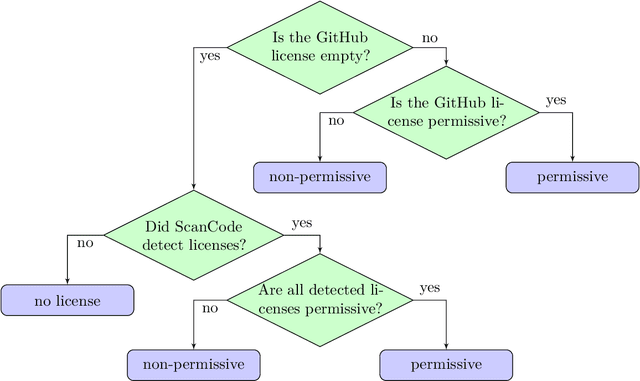
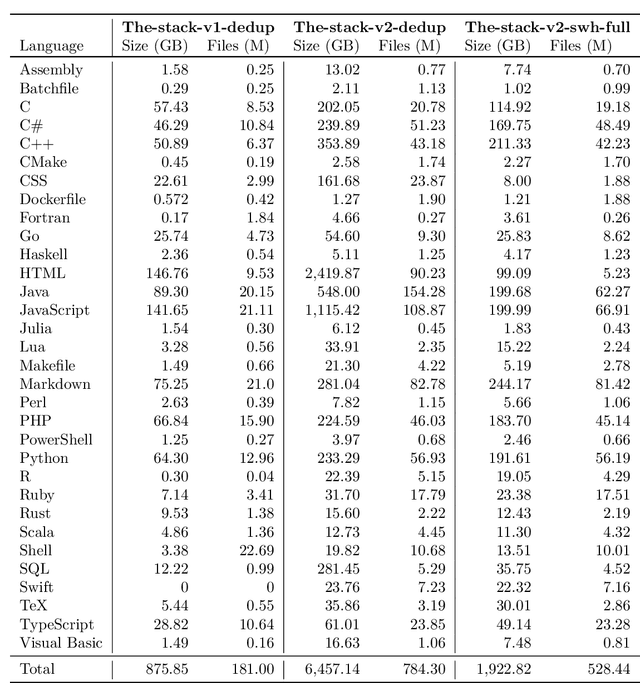
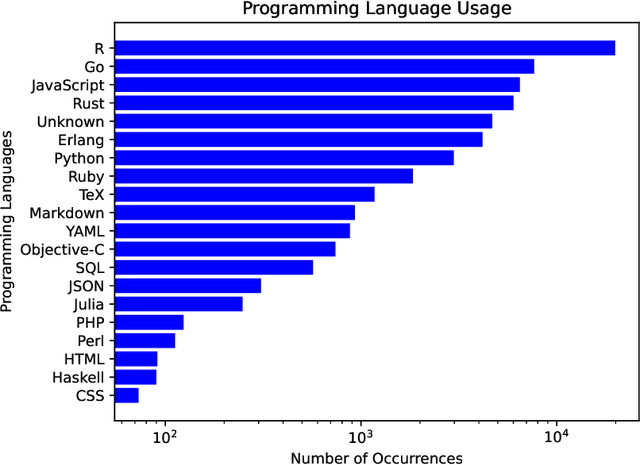
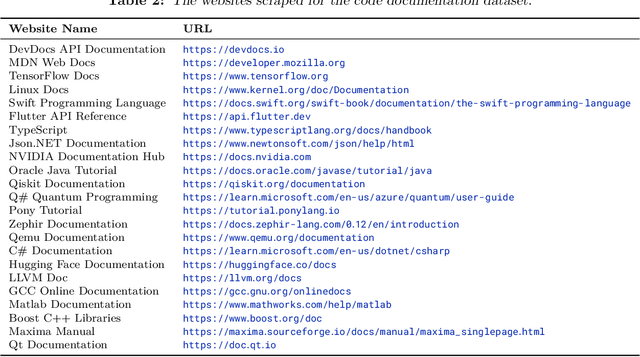
Abstract:The BigCode project, an open-scientific collaboration focused on the responsible development of Large Language Models for Code (Code LLMs), introduces StarCoder2. In partnership with Software Heritage (SWH), we build The Stack v2 on top of the digital commons of their source code archive. Alongside the SWH repositories spanning 619 programming languages, we carefully select other high-quality data sources, such as GitHub pull requests, Kaggle notebooks, and code documentation. This results in a training set that is 4x larger than the first StarCoder dataset. We train StarCoder2 models with 3B, 7B, and 15B parameters on 3.3 to 4.3 trillion tokens and thoroughly evaluate them on a comprehensive set of Code LLM benchmarks. We find that our small model, StarCoder2-3B, outperforms other Code LLMs of similar size on most benchmarks, and also outperforms StarCoderBase-15B. Our large model, StarCoder2- 15B, significantly outperforms other models of comparable size. In addition, it matches or outperforms CodeLlama-34B, a model more than twice its size. Although DeepSeekCoder- 33B is the best-performing model at code completion for high-resource languages, we find that StarCoder2-15B outperforms it on math and code reasoning benchmarks, as well as several low-resource languages. We make the model weights available under an OpenRAIL license and ensure full transparency regarding the training data by releasing the SoftWare Heritage persistent IDentifiers (SWHIDs) of the source code data.
CRUXEval: A Benchmark for Code Reasoning, Understanding and Execution
Jan 05, 2024Abstract:We present CRUXEval (Code Reasoning, Understanding, and eXecution Evaluation), a benchmark consisting of 800 Python functions (3-13 lines). Each function comes with an input-output pair, leading to two natural tasks: input prediction and output prediction. First, we propose a generic recipe for generating our execution benchmark which can be used to create future variation of the benchmark. Second, we evaluate twenty code models on our benchmark and discover that many recent high-scoring models on HumanEval do not show the same improvements on our benchmark. Third, we show that simple CoT and fine-tuning schemes can improve performance on our benchmark but remain far from solving it. The best setup, GPT-4 with chain of thought (CoT), achieves a pass@1 of 75% and 81% on input and output prediction, respectively. In contrast, Code Llama 34B achieves a pass@1 of 50% and 46% on input and output prediction, highlighting the gap between open and closed source models. As no model is close to acing CRUXEval, we provide examples of consistent GPT-4 failures on simple programs as a lens into its code reasoning capabilities and areas for improvement.
Language Agnostic Code Embeddings
Oct 25, 2023Abstract:Recently, code language models have achieved notable advancements in addressing a diverse array of essential code comprehension and generation tasks. Yet, the field lacks a comprehensive deep dive and understanding of the code embeddings of multilingual code models. In this paper, we present a comprehensive study on multilingual code embeddings, focusing on the cross-lingual capabilities of these embeddings across different programming languages. Through probing experiments, we demonstrate that code embeddings comprise two distinct components: one deeply tied to the nuances and syntax of a specific language, and the other remaining agnostic to these details, primarily focusing on semantics. Further, we show that when we isolate and eliminate this language-specific component, we witness significant improvements in downstream code retrieval tasks, leading to an absolute increase of up to +17 in the Mean Reciprocal Rank (MRR).
 Add to Chrome
Add to Chrome Add to Firefox
Add to Firefox Add to Edge
Add to Edge